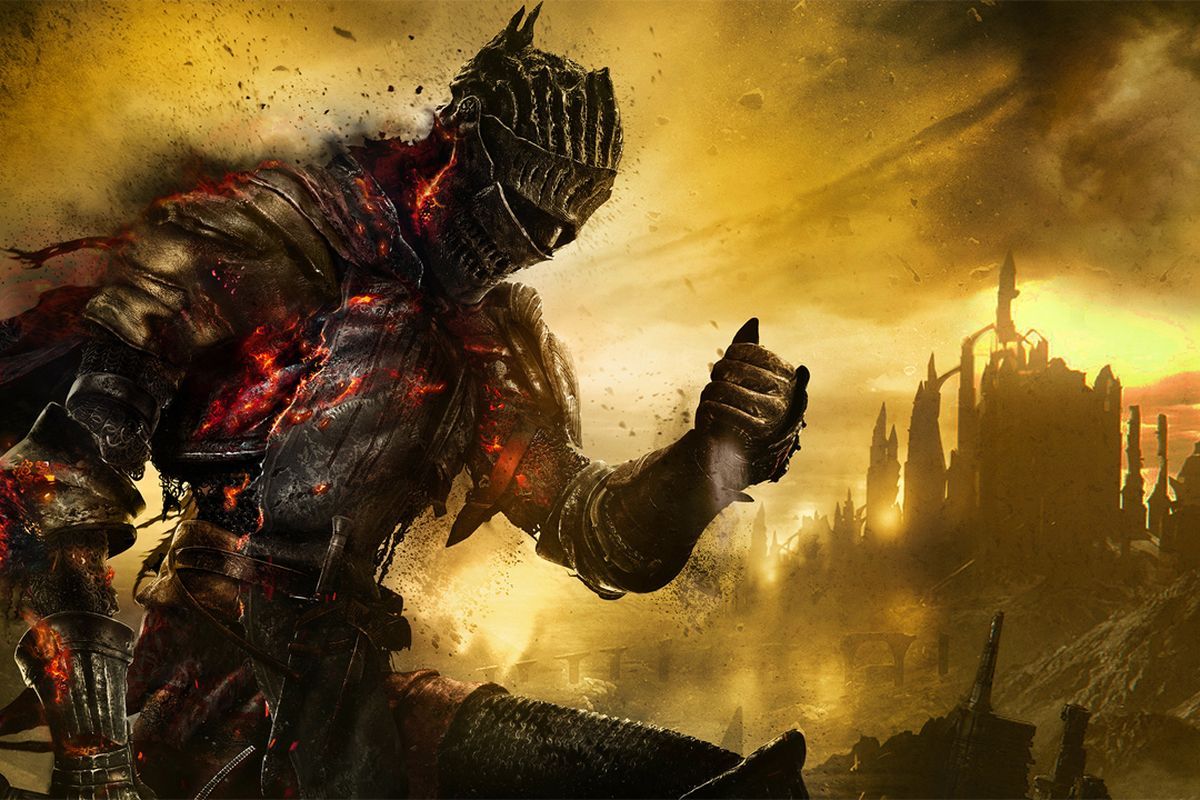Dark Souls: The Game First Impressions
June 29, 2017
I got the chance to play the recently fulfilled Kickstarter project, Dark Souls: The Board Game. A friend of mine backed it and it arrived this week. It’s a co-operative dungeon crawler that has the party fighting through multiple encounters. The ultimate goal is to earn enough Souls to buy new armor and weapons. And to upgrade these items, as well as their own character stats, as each item has specific requirements in order to use them. These items and upgrades will then be used to defeat a Mini-Boss and a Boss, selected by the players during setup.
The party has a limited amount of lives, called Bonfire Sparks, the number of which is determined by the player count. These are used up when a party member dies, which forces the party to rest, or when the party voluntarily rests. Resting will replenish any used expendables the players may have, and more importantly, resets all of the encounters in the dungeon. The party will have to fight in these encounters again, but they also get to farm more Souls.
Once the party decides they are sufficiently geared up, they can take on one of the four Mini-Bosses included in the core box. We took on the gargoyle, with its sweeping axe and tail strikes, and devastating electric breath.
If the Mini-Boss is defeated, the dungeon is then reset with higher level encounters, and the party starts the crawl all over again, this time building up to fight one of the two Bosses included in the core box. We picked the Dancer of the Boreal Valley, but didn’t manage to get to the end fight.
Anybody familiar with the video game series will immediately recognize the enemies and vernacular of the game items and uses. Steamforged Games did a great job recreating the video game in board game form. Taking on the giant gargoyle was giving me flashbacks to how brutally hard that thing was to fight in the original Dark Souls video game. Quickly invoking those messed up masochistic tendencies that keep you coming back for more punishment just to get the satisfaction of finally murdering this thing that has kicked your teeth in twenty times in a row. A feeling that the Dark Souls franchise is synonymous with.
As advertised, we died playing this game. Our very first encounter went extremely terribly, with our “tank” getting wrecked. Ok, that was pretty much to be expected, right? Walk into a room full of baddies not knowing what the hell you’re doing and you’ll probably get a sword or arrow through the face. That’s a big part of this game, learning from your mistakes. Each enemy has a Behaviour Card that dictates their actions; who they target, how far they move, how hard they hit, etc. So going into the same encounter for the second time, we knew how the enemies would act, and were able to strategize accordingly. This felt REALLY good and was very rewarding when we successfully completed the encounter the second time.
This being everybody’s first playthrough, it lagged quite a bit between player turns. All of the enemies act, then one player, then all of the enemies, then the next player, and so on until the encounter ends with your death, or theirs. Always in death. There is a LOT of iconography to learn, which isn’t uncommon for most games, really, so definitely not a fault. Once we got familiar with the icons though, the encounters really started to pick up, and we were blitzing through them, farming souls.
There are three levels of encounter difficulty, the number of each used is dictated by the boss you choose at setup. Stepping into the next level of encounters very noticeably ramped up the difficulty, and it also noticeably matched our skill increase too. So we didn’t get blown out of the water, but also struggled to find the most effective strategy to address the encounter.
The general encounters are fun, but they quickly get stale, especially when you’re farming for Souls. Where this game really shines, and where it feels the most like the video game series, are the boss fights. That gargoyle fight was so damn fun. Like the regular enemies, the boss enemies have specific actions they take, but instead of a single card, they get a whole deck. Each card being a unique attack and move combination. You randomly choose a number of facedown cards from this deck equal to the number indicated on the boss card, forming a new deck of behaviours. Then, when the boss activates, you just reveal the top card, forming a discard pile, and resolve the actions. Once the deck runs out, you just flip the discard pile over to form the deck again, maintaining the order of the cards. This last part is what makes the boss encounters so cool. Like the regular enemy encounters, you can now predict the movement of the boss, assuming you can remember the order of its actions!
The boss figures have four arcs: ahead, behind, left and right. Each attack they do affects one or more of these arcs. There is nothing more satisfying than maneuvering in for a hit in the perfect spot that keeps you safe from the next damn tail sweep that smacked you in the face the last two times it came up. This expert maneuvering is rewarded even further if done correctly. Many of the boss attacks will leave one arc vulnerable, adding an extra attack die when a player attacks there.
Just when you think you’ve mastered the boss’s patterns and have managed to take a good chunk of their health away, they hit their Heat Up Point. You then pull another face down Behaviour Card from the boss’s Heat Up deck. This gets shuffled into the deck that you just friggin mastered, giving you a new order of actions to memorize and adapt to, as well as adding a new, much stronger attack to the mix. I really like this mechanic, it stops the fight from getting stale and keeps the challenge rating up throughout the encounter.
Once defeated, you get some boss loot that is immediately added the the party’s shared inventory, and can be equipped if a player meets the required stat levels. Speaking of loot, there is a lot of it in the game. The Treasure Deck starts with five or six dozen cards in it. For one Soul, you purchase the top card of the deck and add it to the party’s inventory. Getting loot is awesome, and purchasing it has a bit of a push your luck thing going on. You want to get more potentially powerful weapons and armor, but you need Souls to upgrade stats so you can actually use them. But if you don’t have new items, then you don’t know what stats to upgrade in the first place.
The Treasure Deck felt bloated and excessive though. My character ended up in a situation where all of the weapons and armor that were randomly coming up were better suited to the other players. Restricted by our Soul count, the other players needed fewer Souls when upgrading stats to meet item requirements. I played the majority of the game with my base items. Nothing useful or feasibly costed came out of the deck. I still somehow managed to be decently effective and actually only died at the very end of our gaming session. This was due to proper tactics during the encounters. Keeping myself out of danger and ducking in for attacks that would deal maximum effect for the limited abilities that I had. It’s impressive that the gameplay is flexible enough to be able to do that, but I wanted some sweet ass loot too! There was a tipping point though, as the encounter levels increased, that my character just became utterly useless and a liability to the party.
When you put in three and a half hours dungeon crawling, you expect to be pretty geared up when it’s all said and done. That’s three and a half hours just to defeat the mini-boss and an encounter or two after the second setup. We didn’t even get to the main boss fight. Obviously we were slowed down a ton right at the beginning looking up iconography and some combat rules, but damn that is long. I don’t play that many dungeon crawl games, so maybe that’s normal, but the box says sixty to ninety minutes. LIES. A huge part of that excessive time was setup, so much setup! Again, mostly standard in dungeon crawling games, lots of map variations to setup, populating enemies, additional terrain tokens. Once the initial board and decks are setup, however, the encounters are quick to get going. Just a single card that lists what enemies, objects and traps are placed on the board.
You can put in all of that setup time, just to get screwed over by a terrible die roll though. The one party member dies, everybody dies rule is very punishing. Thematically Dark Souls, but still punishing. But that random factor is always going to be present in a game with dice. As long as the game gives the players opportunities to increase their odds of success, either through being able to earn items that increase die count or through mitigating the amount of required rolls made based on gameplay skills and tactics, then you can still have a fun, balanced, and challenging game that doesn’t punish the players. Dark Souls: The Board Game does an adequate job of that.
I would definitely play this game again, and would be interested in playing through the campaign option included in the Core Set. The upcoming expansions will certainly breathe some extra life into the game. There are extra bosses, of course, but also more regular enemies, which this game really needs. The game suffers the most in these regular encounters, which is ninety five percent of the gameplay. More variation of enemies to fight, and varied compositions of enemies to fight, will add a lot more depth and strategy to the game. Enough to justify the price point though? I’m not entirely sold(ba dum dum) on that.
L.
